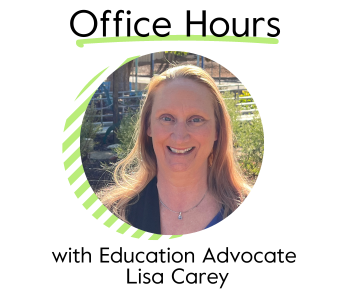Our kids’ lives are full of choices — what snack to eat after school, which backpack to use (Batman or Frozen?!), what skills/hobbies/interests to explore, etc. As parents, we may make choices for our kids while they’re still very young, but it’s important that they are always meaningfully involved in the planning and decisions that affect them, with their thoughts and opinions at the core of these decisions. This principle and practice, which should begin right from their earliest moments, is called person-centered planning — a process that focuses on what an individual can and wants to do (rather than what they can’t do) and the supports, services, and resources needed to achieve their goals.
Person-centered planning should be the focus of everything we do for our kids, including therapies, education, communication, social-recreation, short- and long-term goals, etc. It’s also the compass for the game-changing funding model in the Self-Determination Program (SDP), an alternative to the traditional way of receiving Regional Center services. SDP gives people with disabilities more freedom, control, and responsibility to choose the services and supports that help them meet their goals and be fully included in their community — and a person-centered plan drives the entire process!
A person-centered plan can help a child at any stage of life make more independent choices, honor their preferences, and have a support team rooting for them as they work towards their wants, hopes, and dreams.
Undivided member Martha tells us about her experience with SDP:
“My daughter has been in the new system for seven months, and I have seen a significant difference in her life. She is happy because she works with people who make her feel good; with Self-Determination, she has the right to choose who she wants to work with. She can also choose services that interest her, such as swimming, dancing, and going out into the community with someone the family trusts. I have seen significant improvements in all areas of my daughter’s life but especially in her speech, which I did not see for years in the traditional system.”

This week, we are unraveling the core components of SDP and person-centered planning, including how to get started and get the most out of it.
- Whether your child is already enrolled and you want to get more out of SDP, or you’re interested in learning more about the program, our article Self-Determination 101 discusses common services covered by SDP and how to get them.
- Let’s say Regional Center provided hours but you didn’t use them, had them taken away, or couldn’t use them because you didn’t have anyone to help. Is that an unmet need? Find the answer (and more examples of unmet needs) in our article Unmet Needs: How Self-
Determination Can Help. - If you missed our live event with SDP Program Manager Christine C. Tolbert about getting the most out of Self-Determination, no problem! Find the full replay and recap of the highlights in our article Frequently Asked Questions about the Self-Determination Program.
- Did you know that you can share the results of your child’s person-centered planning meeting — their action plan — with your child’s teacher and have a discussion about how the plan should drive IEP goals? Read more about this in our article Person-Centered Planning 101.
- Wondering if Regional Center might fund your Undivided Membership? Most Regional Centers offer some degree of funding for parent training and education. While we can’t guarantee that any funding request will be approved, you can read our article for tips on making the request through Self-Determination or traditional funding. Good luck, and let us know your experience with this process!
 Thanks to one Undivided Navigator’s expertise in Self-Determination, one of our clients experienced clarity and understanding of the Financial Management Services (FMS) process. With Undivided guidance, the client was able to navigate the complexities of Self-Determination with ease, filling the gap where their Independent Facilitator support seemed lacking. This client went from confusion and uncertainty to being informed and empowered, making confident decisions with ease.
Thanks to one Undivided Navigator’s expertise in Self-Determination, one of our clients experienced clarity and understanding of the Financial Management Services (FMS) process. With Undivided guidance, the client was able to navigate the complexities of Self-Determination with ease, filling the gap where their Independent Facilitator support seemed lacking. This client went from confusion and uncertainty to being informed and empowered, making confident decisions with ease.

IHSS Under Age 18
If your child qualifies for In-Home Supportive Services, how do you know whether you’re making the most of those services? What do you do if IHSS denies your request for more hours? How do you get set up as your child’s paid parent provider — and did you even know that was an option?
Bring all these questions and more to our live event on November 30, where Undivided Public Benefits Specialist Lisa Concoff Kronbeck will bring her expert insight to help us get a handle on all things IHSS. Register for the event here!

On Wednesday, October 18, 12:00–1:00 p.m. PDT, Education Advocate Lisa Carey will be available to answer questions about IEPs and special education. Bi-weekly Office Hours are virtual Q&A sessions with experts that are open to Undivided members only, so if you’d like to attend, sign up here to begin your free Kickstart!
 Whether you have younger or older kids, here’s what the person-centered planning process can look like. Watch on YouTube→
Whether you have younger or older kids, here’s what the person-centered planning process can look like. Watch on YouTube→- Have questions about Self-Determination? Many parents in our community have kids enrolled in SDP, so feel free to ask in our private Facebook group →
- We can encourage our kids to dream big throughout their education as well as thinking about their future. Check out these tips on Instagram→
- Want to share our weekly newsletters with a friend? Find links to our newsletters on LinkedIn→
- Talk to a Navigator about your goals for your child’s future (and their own goals!) and Undivided will help you find supports to get there. Get started for free→
…
This newsletter was originally sent to our subscribers on 10/12/23. Subscribe to our newsletter to get more resources like this in your inbox, or check out our full library of articles, templates, and videos at undivided.io/resources.



























